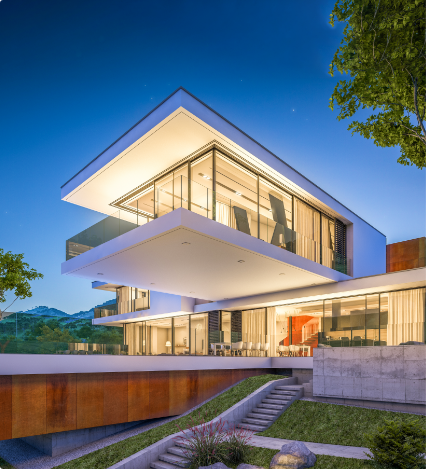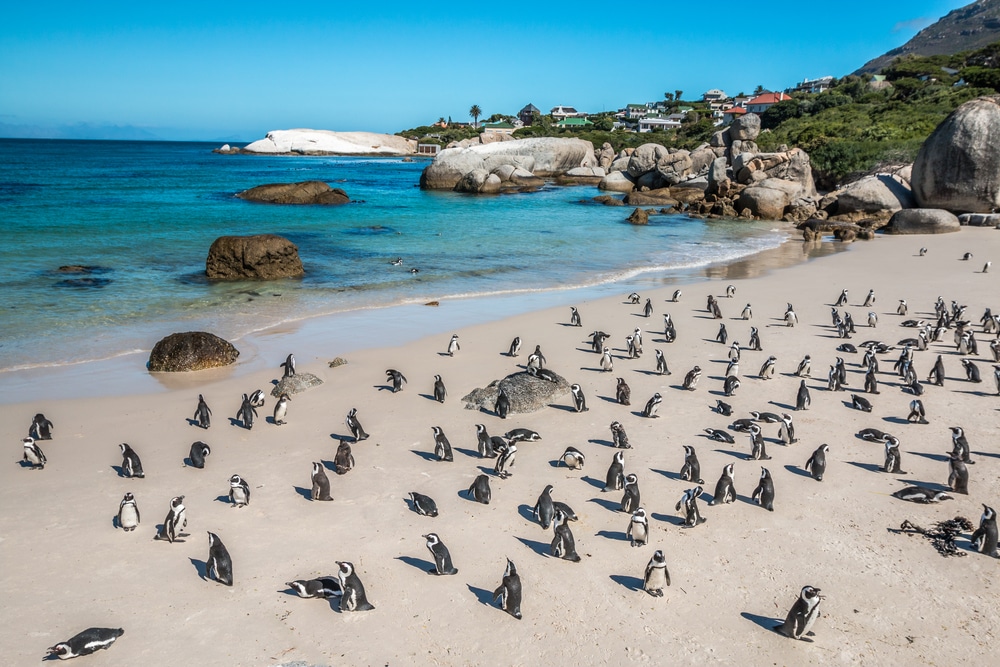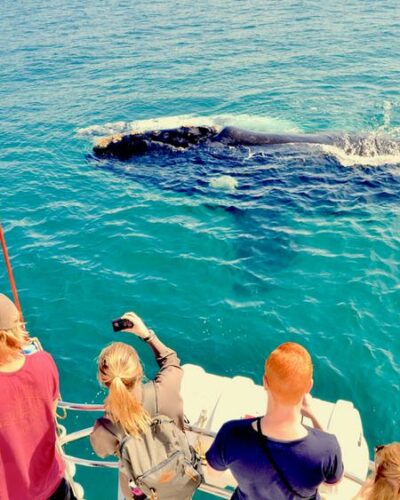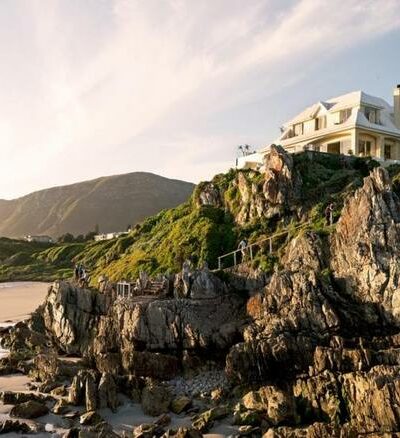Cape Town is one of South Africa’s most popular tourist destinations thanks to its beautiful coastline, gorgeous white sand beaches, and breathtaking mountainous backdrop.
It has a bustling, cosmopolitan atmosphere in its urban regions. In rural areas, tourists can catch glimpses of South African wildlife and enjoy the peace and quiet of beautiful natural settings.
People often choose to holiday in Cape Town because the region has a huge variety of beaches on offer. It’s a fantastic destination for lounging under the sun or heading out into the water to swim, surf or paraglide.
It would be easy to spend an entire trip to Cape Town at its beaches, but visitors should also be sure to check out the many other tourist attractions in the region. Many of them center around nature, wildlife, and the Western Cape’s spectacular landscape.
In this guide, we highlight some of the best places to visit in Cape Town to help you experience this unique region in all its glory.
Victoria & Alfred Waterfront

With around 24 million people visiting annually, the Victoria & Alfred Waterfront is one of South Africa’s most popular destinations. It extends around two harbor basins and offers gorgeous views of the boat-lined harbors, and the iconic Table Mountain serves as an impressive backdrop.
The History
The V&A Waterfront is an integral part of Cape Town’s history. It was here at Table Bay that settlers originally landed on South African shores. The beginnings of a formal harbor first came to be in the 1600s when a small jetty was constructed from which to serve refreshments to crews of visiting ships.
In the 1800s, the first harbor basin, Alfred, was built to protect ships against wrecks which were common in winter storms. By 1920, the Victoria basin was also complete. Since the turn of the 21st century, the harbor has diversified from its original trade routes to focus on retail and tourism, although a working harbor remains at its center.
What to Do
Today, the V&A Waterfront has a lively, cosmopolitan atmosphere. It’s packed with restaurants, cafes, hotels, trendy music venues, museums, cinemas, theaters, and a huge variety of shops stocking both local products and international luxury brands.
The V&A Waterfront’s Canal District is a great spot to enjoy water sports such as swimming, kayaking, and stand-up paddle boarding. The Canal District links the Waterfront with the Cape Town Convention Centre, and water taxis are available to traverse the area as easily as possible.
For a quieter pace, check out Battery Park in the Canal District. Here, you can stroll through indigenous plants in beautifully landscaped gardens or relax in the sunshine on the park’s expansive lawns.
There’s plenty to do for a full day out at the V&A Waterfront, but if you’re staying in the area, you can take your time over the many tourist attractions on offer.
- Two Oceans Aquarium is home to more than 300 species of fish and features a touch tank, diving experiences, a marine predator exhibit, and an opportunity to meet African penguins.
- Scratch Patch lets kids collect their favorite South African gemstones from a floor covered with colorful stones.
- Cape Wheel provides incredible panoramic views of Cape Town and Table Mountain from 120 feet above the ground.
- Springbok Experience Museum offers interactive exhibits which tell the story of South African rugby.
- Green Point Urban Park is home to the Cape Town Stadium, where the 2010 FIFA World Cup matches took place.
- The Nelson Mandela Gateway shares insights into Mandela’s life and his impact on South Africa. It’s from here that visitors can take boat trips to Robben Island, where Mandela was incarcerated.
- Signal Hill is a flat-topped peak that joins Table Mountain and Lion’s Head to create Cape Town’s iconic three-peaked landscape. It can be hiked within 90 minutes and offers incredible views at sundown.
Boulders Beach

Boulders Beach is part of the Table Mountain National Park Marine Protected Area and home to an endangered African penguin colony.
The beach itself is beautiful, with white sands and a scattering of giant granite boulders, which help to protect it against strong Atlantic winds. The real appeal of visiting is the opportunity to see 2,000 African penguins in their natural habitat.
Beach Penguins
A series of raised walkways allow visitors to access brilliant views of the penguins, but you’re also free to perch on rocks or lay towels out on the sand. There are plenty of rock pools for kids to investigate and calm bays for safe dips in the water, although you might find the Atlantic Ocean is a little too chilly for swimming.
The penguins at Boulders Beach are very used to living in close proximity to humans, which means it’s easy to get close to them. They’re confident and charismatic little birds and offer no end of entertainment for kids and adults alike. Make sure children don’t get too close because the penguins can give a nasty bite.
Since Boulders Beach is a nature reserve, there’s an entrance fee to access it. Funds go towards preserving the endangered penguin colony and other wildlife in the area.
The walkways are accessible for wheelchair users and families with pushchairs, making it a fantastic sightseeing opportunity for everyone. You can also take a walk to nearby Foxy Beach to access walkways that offer views of the prime penguin sites.
Other Cape Town Beaches
If you’re happy to forgo penguin sightings and looking for a beach closer to Cape Town city center, there are plenty of alternatives.
- Clifton Beaches are protected from strong winds thanks to the giant granite mountain ridge of Table Bay, known as the Twelve Apostles, thanks to its twelve peaks.
- Camps Bay Beach offers spectacular views of the Twelve Apostles, Table Mountain, and Lion’s Head.
- Hout Bay lies close to Chapman’s Peak for incredible views and a calm, relaxed atmosphere.
- Queens Beach is a small, sheltered beach that offers peace and quiet in the busy Sea Point region.
- Llandudno Beach is known for its exclusive hillside neighborhood and family-friendly atmosphere.
Gansbaai for Shark Cage Diving

Shark cage diving is a popular activity for adrenaline junkies during a visit to South Africa. This is where you have the opportunity to see great white sharks from mere inches away while being protected from harm by a strong iron cage. Great white sharks are deemed one of the most frightening predators of the ocean, and cage diving is the best way to experience their impressive size and stature.
Where to Shark Dive
The densest population of great white sharks in South Africa is around Dyer Island near Gansbaai. The area of water that stretches between Dyer Island and nearby Geyser Rock is known as Shark Alley, and it is deemed the best place in the world for shark cage diving.
It’s best to visit between the months of April and October, as this is when the local shark population is at its highest.
Watch from the Boat
If cage diving isn’t for you, you can simply watch the action from the boat instead. The sharks feed at the surface of the water, so when they investigate the cages, they’re easily visible to those on the boat. Alternatively, you can take a boat trip that focuses on other common marine life in the region, such as seals, dolphins, penguins, and whales. A guided tour of the waters here is bound to give you fantastic insights into South African marine life.
A Beautiful Roadtrip
Gansbaai is 100 miles away from Cape Town itself. The trip is definitely worthwhile if you want the best chance of seeing sharks, and since the scenery on the Western Cape is so mountainous and impressive, you’re bound to enjoy the drive.
Gansbaai has a rugged and largely unspoiled coastline, making it a scenic destination for a day out. There’s plenty of marine and bird life to observe, and many visitors use the town’s hiking trails to explore more of Cape Town’s rural landscape.
Other Areas for Shark Cage Diving
If you’d prefer not to spend so much time on the road, you can find cage diving opportunities in Simon’s Town, which is in the False Bay Region and just 24 miles from Cape Town city center.
In addition to shark cage diving, consider taking a tour of Seal Island, which is just off the coast. A large colony of Cape fur seals inhabits the island, and they’re very used to boats pulling up nearby, so you can expect fantastic views.
Seals are the favorite prey of great white sharks, so you might be lucky enough to spot some sharks during your trip, too.
Bo-Kaap and The Circle of Karamats

Bo-Kaap is a region of Cape Town that was formally a racially segregated area known as the Malay Quarter. It is renowned for its cobblestoned streets and bright buildings that are painted in pastel shades.
The district is currently known as being incredibly multicultural, but it was once home exclusively to a community known as the Cape Malays. Cape Malays were slaves brought to South Africa by the Dutch from Malaysia, Indonesia, and other African regions to work in the Cape during the 1600s.
A Cultural Destination
They were known as such because they used the common language of Malay. Today, the term “Cape Malay” is controversial because it was originally used to racially classify and abuse people throughout the apartheid regime.
Communities of the Bo-Kaap district have a distinct culture that has influenced Cape Town and South Africa. For example, Islam was originally brought to South Africa by the Cape Malays.
Afrikaans, which is South Africa’s national language, began when the Malay language was blended with Dutch by the Cape Malays. The community also played a vital role in battling against the unjust apartheid regime that ended in the 1990s.
Unique Architecture
In the 1760s, properties were built in the Malay Quarter and leased to the Cape Malays. The unique architecture of these properties, a blend of Cape Dutch and Georgian styles, gives the Bo-Kaap region its recognizable look today.
Originally, inhabitants were not permitted to paint their leased houses anything other than white. Once slavery was abolished, and former slaves had the right to purchase their homes, painting properties in bright colors served as an expression of freedom.
You can learn about the Bo-Kaap community and its complex history and culture by visiting the Bo-Kaap Museum, which is located in the oldest building in the district on Wale Street. The Auwa Mosque, which was the first Muslim mosque to be established in South Africa, is nearby.
The Circle of Kramats
You can also tour the Circle of Kramats, which is a series of tombs of Holy Men of Islam who played integral roles in building the Muslim community in South Africa.
Many Muslims consider visiting the Kramats an act of pilgrimage to show their respect. Consider booking a guided tour of Bo-Kaap and the Circle of Kramaats with a local resident to get fascinating insights into the history, culture, and cuisine of the Bo-Kaap community.
Noordhoek

Noordhoek is a village situated at the base of Chapman’s Peak and in Table Mountain National Park. Its location gives it a wild, rural, and incredibly beautiful charm that makes it a popular escape for Cape Town locals.
It offers sandy beaches, incredible views of the surrounding mountains, and opportunities to see local wildlife.
Local Wildlife
It’s common to catch sightings of wild peacocks, Egyptian geese, guinea fowl, and meerkats throughout Noordhoek village and the surrounding valley. Look out for the black eagle overhead, and listen for calls of the fish eagle as it soars over the nearby mountain range.
You’ll also hear plenty of owls hooting at night, thanks to the quiet, peaceful nature of Noordhoek nightlife.
A Grand Roadtrip
Just 22 miles away from the Mother City, Noordhoek is a brilliant choice for a day trip if you want a break from the hustle and bustle of Cape Town. It’s a small neighborhood with a friendly community and a good range of artisanal shops, cafes, and restaurants.
The Farm Village is a hub for food, drink, and atmosphere. It’s home to a number of restaurants, some beautiful clothing boutiques, a coffee shop, an ice cream shop, a delicatessen, and a live music venue. There’s also a playground for kids to enjoy.
While Noordhoek is renowned for its quiet pace of life, there’s no shortage of activities on offer, such as:
- Horse riding at one of the stables in the area, which caters to riders of all experience levels, including complete beginners.
- Hiking on one of the many trails in the countryside surrounding the village, including a half-day route up Chapman’s Peak for incredible views of the entire Cape Peninsula.
- Guided tours of the nearby township of Masiphumelele, where you can chat with locals, eat traditional food, and learn about local customs.
Noordhoek Beaches

If you love visiting sandy beaches, be sure to drive out to nearby Long Beach, which, at five miles long, has plenty of room for sunbathing, walking, playing volleyball, and surfing. Long Beach runs all the way down to the town of Kommetjie.
There are very few amenities along the way, so pack plenty of supplies and check tide times carefully if you plan to walk the entire length. Most people head to the halfway point to explore the shipwreck of Kakapo, which is a unique sight to behold on this sparse stretch of coastline.
A day tour to Noordhoek allows you to experience Chapman’s Peak Drive. This incredible stretch of road offers such impressive views that it is regularly featured in car commercials. If you plan to rent a car during your visit to Cape Town, a drive on Chapman’s Peak Drive is a must.
Winelands Region

The Western Cape Winelands Region is an essential visit for wine buffs and a great way to explore the Cape Town countryside. The region is mountainous, with a series of sandstone peaks and broad, fertile valleys. It’s in these valleys where some of South Africa’s most renowned vineyards reside.
A Brilliant Climate
The Winelands Region’s Mediterranean climate makes it a brilliant environment for successful viticulture. Summers are dry and hot, while winters are cool and damp, but the weather is never too extreme.
Pinotage is the signature variety of grape in South Africa. Cabernet Sauvignon, Sauvignon Blanc, and Shiraz also thrive in the Western Cape.
Getting There
It takes less than an hour to reach the Winelands region by car from central Cape Town. There are many vineyards in the region, but the most renowned are based in Paarl, Stellenbosch, and Franschhoek.
Keep in mind that you may need to book tours of individual wine estates in advance, so plan your trip carefully. Some tours are as simple as strolling through vineyards. Others include cellar tours, wine tasting, and even lunch to help you learn about food and wine pairings.
A great way to get around the region is to take the Franschhoek Wine Tram, which has a hop-on-hop-off service to let you visit any of the vineyards on the route. You’ll get incredible views of the Franschhoek valley as you travel. Narration along the way gives you a fascinating insight into the history of wine cultivation in the region.
False Bay for Whale Watching

Whale-watching cruises are popular Cape Town attractions throughout the region, but they’re particularly good in False Bay and the surrounding Simon’s Town area. False Bay is a curve on the southwest coast of South Africa. It runs from Cape Point to Cape Hangclip.
Surfing and Swimming
False Bay’s waters are popular with surfers and swimmers because they’re exposed to southeasterly winds and the subtropical Agulhas Current. This makes them much warmer than those in the Table Bay Region on the West Coast.
Whale Watching
Muizenberg, St James, Kalk Bay, Glencairn, and Simon’s Town are all fantastic places for whale watching, particularly during summer and autumn.
Southern right whales are the most common species spotted in Cape Town waters. They migrate from Antarctica to calve offspring between June and November. They can be identified by their long, arching mouths and double blowholes. They usually have patches of rough skin on their heads where barnacles cling to them.
Humpback whales can be seen around Cape Town between May and November while migrating from polar regions. They head to the warmer waters of Madagascar and Mozambique to breed and calf. Humpbacks are known for their obviously humped shape and knobbly heads.
Bryde’s whales are present in Cape Town waters all year round, but they’re hard to spot. They dive for long periods and to deep depths and surface very briefly. You can identify them by their large, dark grey bodies, which are white on the underside. You might also notice three ridges near their blowhole.
Pro Tip: There are plenty of cruise operators in the False Bay region offering whale-watching tours. Sometimes the waters can be choppy, making boat travel unpleasant for those who get seasick. Check the weather forecast before buying tickets.
Explore Cape Town
Since there’s no shortage of tourist attractions in Cape Town, choosing which ones to fit into your trip is the hardest part. With such impressive scenery to explore along the way, it’s wise to travel far and wide across the region to soak up South Africa’s beauty.













